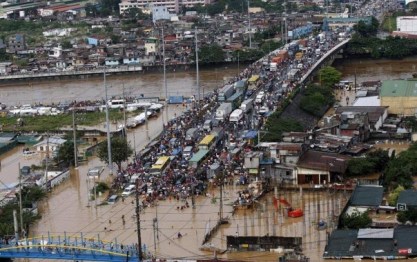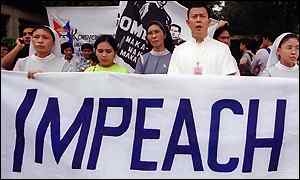In just a week, the first decade of the twenty-first century will soon end. The advent of the new millenium has brought excitement and hope to most people. In the same way, the dawn of this presummably special decade was indeed fresh. We welcomed the year 2000 with excitement, hoping for positive changes. As the last week of the last year of the first decade of the twentyfirst century closes, let’s look back at the decade that was.
2000
December, Impeachment Trial of Pres. Joseph Estrada begins. President Estrada makes history, as he becomes the first Philippine president — and the only Asian leader — to undergo an impeachment trial.
2001
January, The EDSA Revolution of 2001, also called EDSA II (pronounced as EDSA Dos or EDSA 2) or the Second People Power Revolution, is the common name of the four-day popular revolution that peacefully overthrew Philippine President Joseph Estrada from January 17 – January 20, 2001. He was succeeded by his then vice president Gloria Macapagal-Arroyo.

April, so-called EDSA 3: Street protest of the masses supporting deposed Estrada.
EDSA III (pronounced EDSA Tres) was a protest sparked by the arrest in April 2001 of newly deposed President Joseph Estrada of the Philippines. The protest was held for seven days in a major highway in Metropolitan Manila, the Epifanio de los Santos Avenue or EDSA, which eventually culminated in an attempt to storm the Malacañang presidential palace. Taking place four months after EDSA Revolution of 2001, the protests were asserted as a more populist and representative uprising in comparison to the previous demonstrations in the same location, in January 2001. The protests and the attack on the presidential palace, however, failed in their objectives. Participants continue to claim that it was a genuine People Power event, a claim disputed by the participants and supporters of EDSA II. President Gloria Macapagal-Arroyo has acknowledged the divisive nature of the two terminologies by saying in one statement that she hoped to be the president of “EDSA II and EDSA III.”
2003
July, Ooakwood Mutiny. A group of 321 armed soldiers who called themselves “Bagong Katipuneros” (Filipino: New Katipuneros) led by Army Capt. Gerardo Gambala and LtSG. Antonio Trillanes IV of the Philippine Navy took over the Oakwood Premier Ayala Center (now Ascott Makati) serviced apartment tower in Makati City to show the Filipino people the alleged corruption of the Gloria Macapagal-Arroyo administration. The group was dubbed “Magdalo” by the press, in a reference to the insignia they adopted during the incident—the perceived flag of the Magdalo faction of the Katipunan during the Philippine Revolution. Sources conflict on whether the eight-rayed-sun version of the flag was used by the Magdalo faction, the sixteen-rayed-sun version of the flag was used by the Magdiwang faction, or vice-versa.
July
2004
June, Arroyo wins over celebrity FPJ in 2004 presidential elections.
2005
June, Hello Garci scandal. The scandal involves incumbent president Gloria Macapagal-Arroyo, who allegedly rigged the 2004 national election in her favor. The official results of that election gave Gloria Macapagal-Arroyo and Noli de Castro the presidency and vice-presidency, respectively. Hundreds of national and local positions were also contested during this election. The scandal and crisis began in June 2005 when audio recordings of a phone call conversation between President Arroyo and then Election Commissioner Virgilio Garcillano allegedly talking about the rigging of the 2004 national election results, were released to the public. This escalated, when the minority of the lower house of Congress attempted to impeach Arroyo. This was blocked by Arroyo’s coalition in September 2005.
July, 10 Cabinet members resign. Ten members of President Gloria Macapagal Arroyo’s Cabinet resigned Friday and urged the Philippine leader to step down, saying she has been crippled by an election scandal and has lost the ability to govern.It was the latest blow to Arroyo, embroiled in accusations that she talked to an election official about ensuring a million-vote victory in last year’s presidential vote.
The resignations came after a defiant Arroyo gave a hastily arranged radio address Thursday night, saying she won’t step down and asking her entire Cabinet to resign to give her maneuvering room to survive her biggest crisis.
The crisis was followed by massive calls to impeach PGMA. In the succeeding months, particularly in September when the impeachment notion was turned down by the House, protests sprouted on the streets calling for the PGMA’s resignation. Arroyo, unwavered, called Congress for Charter Change instead. Pathetic.
2006
February, Guinsaugon landslide buries village people; Arroyo places Manila under State of Emergency after security forces thwarted a plot to overthrow her.
The Philippines was under a state of emergency, announced by presidential spokesperson Ignacio Bunye on the morning of February 24, 2006, by the virtue of Proclamation No. 1017. This occurred after the government claimed that it foiled an alleged coup d’état attempt against the administration of Philippine President Gloria Macapagal-Arroyo earlier that same day. The Philippine government security service also claimed that it had arrested a general who was involved in the coup attempt. The president lifted the state of emergency on March 3, 2006 by the virtue of Proclamation No. 1021.
The state of national emergency also led to a temporary suspension of lower-level education classes and an immediate revocation on all licenses and permits to hold demonstrations and protests. The Arroyo administration, informally known as Malacañang, after the presidential palace, also suspended all public activities on the same day and even on succeeding days. Under the provisions in the constitution of the Philippines, at the moment, the government is allowed to detain anyone indefinitely without the privilege of the writ of habeas corpus.
President Arroyo assures that the situation was under control [1] and the state of emergency would not be abused [2].
Arroyo had justified her declaration of a state of emergency with her statement of “clear and present danger to our republic that we have discovered and thwarted.” Critics claim that this is an attempt by Arroyo to seize political power due to her sagging influence and popularity, and some draw similarities to the actions of deposed Philippine president Ferdinand Marcos when he declared martial law in 1972.
On March 3, 2006 (one week after the proclamation), by the virtue of Proclamation No. 1021, the President called off the state of emergency.
2007
January, ASEAN leaders meet in Cebu
 September, THE trial lasted six long years and was peppered by hundreds of motions and counter-motions, allegations and counter-allegations in and out of court, deferments and delays. In September, the Sandiganbayan finally found former president Joseph Ejercito Estrada guilty of plunder, but acquitted him on the charges of perjury. Acquitted of plunder charges were his co-accused, son Jose ‘Jinggoy’ and lawyer Edward S. Serapio. (PCIJ) In October, Estrada was released from jail via presidential pardon.
September, THE trial lasted six long years and was peppered by hundreds of motions and counter-motions, allegations and counter-allegations in and out of court, deferments and delays. In September, the Sandiganbayan finally found former president Joseph Ejercito Estrada guilty of plunder, but acquitted him on the charges of perjury. Acquitted of plunder charges were his co-accused, son Jose ‘Jinggoy’ and lawyer Edward S. Serapio. (PCIJ) In October, Estrada was released from jail via presidential pardon.
2009
August, Corazon Aquino died; People gather to pay tribute to a beloved president.


September, typhoon Ondoy fuses with monsoon causing 7-hour-non-stop rain that submerged Metro Manila and nearby regions under flood.
November, Maguindanao massacre marks the worst politically-related violence in the country.


August, September and November of last year were really one for the history books, innit?